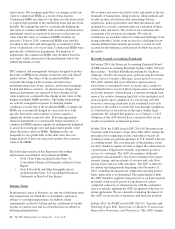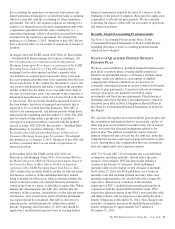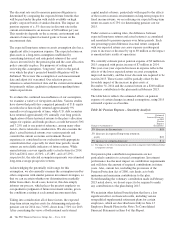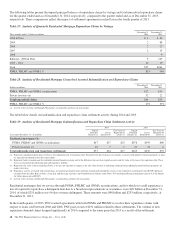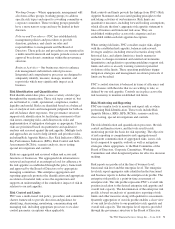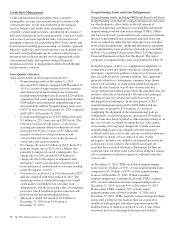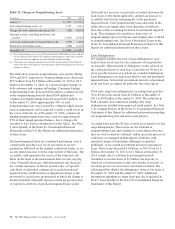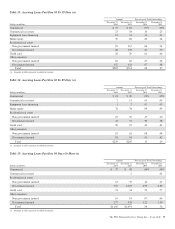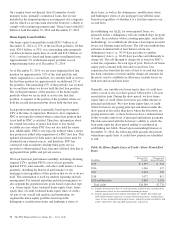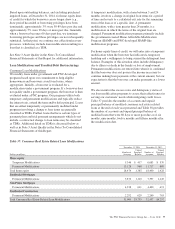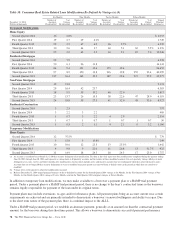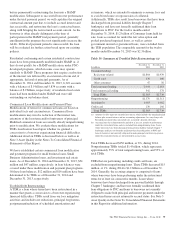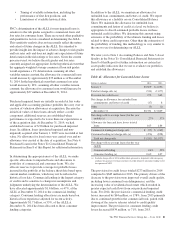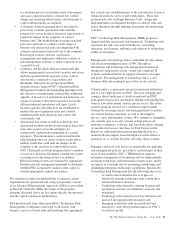PNC Bank 2014 Annual Report Download - page 92
Download and view the complete annual report
Please find page 92 of the 2014 PNC Bank annual report below. You can navigate through the pages in the report by either clicking on the pages listed below, or by using the keyword search tool below to find specific information within the annual report.
Table 32: Change in Nonperforming Assets
In millions 2014 2013
January 1 $ 3,457 $ 3,794
New nonperforming assets (a) 2,127 3,343
Charge-offs and valuation adjustments (b) (585) (1,002)
Principal activity, including paydowns and
payoffs (1,001) (1,016)
Asset sales and transfers to loans held for sale (570) (492)
Returned to performing status (548) (1,170)
December 31 $ 2,880 $ 3,457
(a) New nonperforming assets in the 2013 period include $560 million of loans added in
the first quarter of 2013 due to the alignment with interagency supervisory guidance
on practices for loans and lines of credit related to consumer lending.
(b) Charge-offs and valuation adjustments in the 2013 period include $134 million of
charge-offs due to the alignment with interagency supervisory guidance discussed in
footnote (a) above.
The table above presents nonperforming asset activity during
2014 and 2013, respectively. Nonperforming assets decreased
$577 million from $3.5 billion at December 31, 2013 to $2.9
billion at December 31, 2014, as a result of improvements in
both consumer and commercial lending. Consumer lending
nonperforming loans decreased $224 million, commercial real
estate nonperforming loans declined $184 million and
commercial nonperforming loans decreased $167 million. As
of December 31, 2014, approximately 90% of total
nonperforming loans were secured by collateral which lessens
reserve requirements and is expected to reduce credit losses in
the event of default. As of December 31, 2014, commercial
lending nonperforming loans were carried at approximately
65% of their unpaid principal balance, due to charge-offs
recorded to date, before consideration of the ALLL. See Note
3 Asset Quality in the Notes To Consolidated Financial
Statements in Item 8 of this Report for additional information
on these loans.
Purchased impaired loans are considered performing, even if
contractually past due (or if we do not expect to receive
payment in full based on the original contractual terms), as we
accrete interest income over the expected life of the loans. The
accretable yield represents the excess of the expected cash
flows on the loans at the measurement date over the carrying
value. Generally decreases, other than interest rate decreases
for variable rate notes, in the net present value of expected
cash flows of individual commercial or pooled purchased
impaired loans would result in an impairment charge to the
provision for credit losses in the period in which the change is
deemed probable. Generally increases in the net present value
of expected cash flows of purchased impaired loans would
first result in a recovery of previously recorded allowance for
loan losses, to the extent applicable, and then an increase to
accretable yield for the remaining life of the purchased
impaired loans. Total nonperforming loans and assets in the
tables above are significantly lower than they would have
been due to this accounting treatment for purchased impaired
loans. This treatment also results in a lower ratio of
nonperforming loans to total loans and a higher ratio of ALLL
to nonperforming loans. See Note 4 Purchased Loans in the
Notes To Consolidated Financial Statements in Item 8 of this
Report for additional information on these loans.
Loan Delinquencies
We regularly monitor the level of loan delinquencies and
believe these levels may be a key indicator of loan portfolio
asset quality. Measurement of delinquency status is based on
the contractual terms of each loan. Loans that are 30 days or
more past due in terms of payment are considered delinquent.
Loan delinquencies exclude loans held for sale and purchased
impaired loans, but include government insured or guaranteed
loans and loans accounted for under the fair value option.
Total early stage loan delinquencies (accruing loans past due
30 to 89 days) decreased from $1.0 billion at December 31,
2013 to $0.8 billion at December 31, 2014. The reduction in
both consumer and commercial lending early stage
delinquencies resulted from improved credit quality. See Note
1 Accounting Policies in the Notes To Consolidated Financial
Statements of this Report for additional information regarding
our nonperforming loan and nonaccrual policies.
Accruing loans past due 90 days or more are referred to as late
stage delinquencies. These loans are not included in
nonperforming loans and continue to accrue interest because
they are well secured by collateral, and/or are in the process of
collection, are managed in homogenous portfolios with
specified charge-off timeframes adhering to regulatory
guidelines, or are certain government insured or guaranteed
loans. These loans decreased $.4 billion, or 26%, from $1.5
billion at December 31, 2013 to $1.1 billion at December 31,
2014, mainly due to a decline in government insured
residential real estate loans of $.3 billion, the majority of
which we took possession of and conveyed the real estate, or
are in the process of conveyance and claim resolution. The
following tables display the delinquency status of our loans at
December 31, 2014 and December 31, 2013. Additional
information regarding accruing loans past due is included in
Note 3 Asset Quality in the Notes To Consolidated Financial
Statements of this Report.
74 The PNC Financial Services Group, Inc. – Form 10-K


